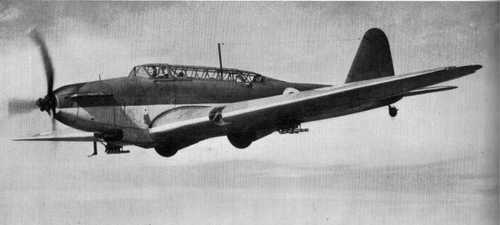
British Forces
Fairey Battle.
H.M. Government.
Resulting from an Air Ministry specification of 1933, the Fairey Battle was intended as a replacement for earlier, biplane light day bombers. The first prototype flew in 1936, and the new bomber entered service with the RAF in 1937, at which time it was adopted as a standard day light bomber. Unfortunately for the RAF, the Battle was effectively obsolete at the time of its adoption, having been overtaken by the pace of aircraft development in the 1930s. Its light load of small bombs (4 250lb bombs carried internally, 2 250lb or 1 500lb bomb externally) was generally incapable of inflicting substantial damage in practical use. Defensive armament (mainly one .303 inch machine-gun rear-mounted and operated by the aircraft's gunner/navigator, along with one .303in wing-mounted) was inadequate. Furthermore, the Battle was much slower than what turned out to be its main opponent and nemesis, the German MeBf 109E. In addition to allocations to the Belgian Air Force, 10 squadrons of Battles formed the vanguard of the RAF's Advanced Air Striking Force in France. Belgian and British Battles were pressed into action in the opening days of the Battle of France (from 10 May, 1940). Initial results were discouraging, with heavy losses suffered. Apart from the problem of enemy fighters, the low-level raids favoured in the opening days of the Battle exposed the aircraft to light anti-aircraft fire from to ground, to which it proved seriously vulnerable. The climax - and beginning of the end - of the Battle's frontline career came on 11/12 May, 1940, on which Battles, along with French Air Arm bombers, conducted low-level attacks on bridges being used by the Germans in their Maas bridgehead. In spite of the presence of Hurricane fighter cover, most of the Battles fell victim to the "Emils" and ground fire. Little damage to the bridges resulted. One RAF squadron - 12 Squadron ("the Dirty Dozen") temporarily ceased to exist as a fighting unit (having already suffered losses on the 11th, it was literally annihilated on the 12th). Irish-born Flying Officer Donald Garland and his rear gunner/navigator, Sergeant Thomas Grey of 12 Squadron (Battle PH-K), were awarded the Victoria Cross (posthumously) for their gallant conduct in pressing home a low-level attack against murderous anti-aircraft fire. While, in the absence of an alternative, the Battle, along with the light-medium Bristol Blenheim, continued to be involved in operations over France for the remainder of the campaign - generally in high-altitude bombing for which they were not designed, and which had little impact. As the equipment and operational profile of the RAF changed, the Battle was withdrawn to secondary employments, including training and target towing. Best regards, JR.
2510 Views
1/17/2014
